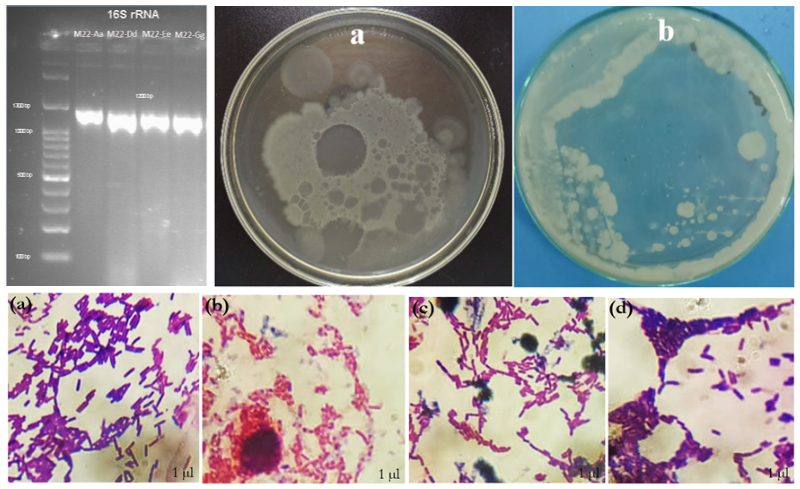Isolation and Identification of Lactic Acid Bacteria in Sinjai Typical Drinks (MINAS)
Abstract
A fermented drink produced locally in the Sinjai area that is well known in the local community as well as widely is Minas. Minas, which means a typical Sinjai drink, used to be known as Irex. However, over time this drink was replaced with the name Minas because it was only produced in Sinjai City and used as a typical Sinjai drink has properties and benefits to increase body stamina due to fatigue after doing daily activities or work. Minas are made from cassava tapai, young coconut, eggs, coconut water, sugar water, honey, and milk and can be added with other fruits such as durian. Curved tape is a type of food produced from the fermentation process of substrates or carbohydrate foodstuffs using yeast yeast which belongs to the group of lactic acid bacteria. To determine the type of lactic acid bacteria that play a role in the fermentation process of minas drinks by isolating and identifying morphology using the gram staining method, biochemical tests using catalase tests, gas production and carbohydrate fermentation tests. Furthermore, molecular identification uses 16S RNA. The DNA sequencing results were analyzed with MEGA 6 software with the BLASTn algorithm at NCBI. Based on the results of the identification of lactic acid bacteria, homologous nucleotides were detected with the bacteria Bacillus subtilis, Bacillus and Streptococcus sp which are a group of lactic acid bacteria that are able to ferment carbohydrates to produce lactic acid.
References
Bergey, D. H., K. N. R. and H. J. G. (1984). Bergey's Manual of Systematic Bacteriology. Second Edition. Vol 3. Williams & Wilkins. Baltimore.
Brooks, G.F., C. K. B. J. M. S. M. TA. J. M. & A. (2010). Medical Microbiology. In Medical Microbiology (eds. J. M. & A. Adityaputri A, Ed.). EGC.
Detha, A. (2019). Characteristics of lactic acid bacteria isolated from sumba horse milk. Journal of Veterinary Studies, 7(1), 85–92.
Fadhilah, A. N., Hafsan, H., & Nur, F. (2015). Reduction of cholesterol levels by lactic acid bacteria from dangke in vitro. Proceedings of the National Seminar on Biology, 1(1).
Hasanah, U. (2014). Identification of Lactic Acid Bacteria in the innards of mackerel peda (Rastrelliger sp.) as a probiotic agent. Journal of Scientific Research, 14(1), 64–75.
Hidayat N, P. S. R. A. M. E. A. (2020). Fermentation Technology. IPB Press.
Ismail, Y. S., Yulvizar, C., & Putriani, P. (2017). Isolation, characterization and testing of antimicrobial activity of lactic acid bacteria from fermentation of cocoa beans (Theobroma cacao L.). Bioleuser Journal, 1(2).
Khristnaviera, B. Y., & Meitiniarti, V. I. (2017). Isolation of lactic acid bacteria from kimchi and its ability to produce anti-bacterial substances. Scripta Biologica, 4(3), 165–169.
Mergypta, D., Budiharjo, A., & Kusdiyantini, E. (2014). Isolation, characterization of lactic acid bacteria, and proximate analysis of fermented anchovy rusip (Stolephorus sp.). Academic Journal of Biology, 3(2), 11–19.
Nudyanto, A., & Zubaidah, E. (2015). Isolation of Exopolysaccharide-Producing Lactic Acid Bacteria from Kimchi [In Press, April 2015]. Journal of Food and Agroindustry, 3(2).
Pelczar MJ, C. E. (2010). Hadioetomo RS, Imas T, Tjitrosomo SS, Numeral SL, Translator; Jakarta: UI Pr. Translation from: Elements Of Microbiology. Universitas Indonesia Press.
Puspita, F., Ali, M., & Pratama, R. (2017). Isolation and characterization of the morphology and physiology of Bacillus sp. endophytic of oil palm plants (Elaeis guineensis Jacq.). Journal of Tropical Agrotechnology, 6(2), 44–49.
Rahmah, W., Nandini, E., Ressandy, S. S., & Hamzah, H. (2021). Karakterisasi Bakteri Asam Laktat (Bal) Dari Fermentasi Tape Singkong: Characterization Of Lactic Acid Bacteria (Lab) From Fermentation Of Cassava Tape. Indonesian Journal of Pharmaceutical Research, 10(1), 1–5.
Rahmawati, M. N. N. A. A. A. Y. R. (2019). Determination of Alcohol Levels in Minas (Sinjai Typical Drinks) Traded in Sinjai City. Journal of Medika, 4(2), 2540–7910.
Riadi, S., Situmeang, S. M. F., & Musthari, M. (2017). Isolation and testing of antimicrobial activity of lactic acid bacteria (BAL) from yogurt in inhibiting the growth of Escherichia coli and salmonella typhi bacteria. Journal of Bioscience, 3(3), 144–152.
Rini C.S., J. R. (2020). Basic Bacteriology. UMSIDA Press.
Rompis, T. J., Bodhi, W., & Budiarso, F. (2018). Bacterial Resistance Test to Arsenic Isolated from Sediment at the Totok River Estuary. E-Biomedicine, 6(2).
Sahirman, S. (2021). Organoleptic and Proximate Analysis of Natto (Yellow Soy Fermented Food by The Bacterium Bacillus subtilis natto). Journal of Halal Agroindustry, 7(1), 63–70.
Sulistiani, S., & Hidayat, I. (2020). Molecular Identification of Lactic Acid Bacteria from Tempeh and Tape Based on 16S rRNA Gene Sequence. Scientific Journal of Biosphere Biology: A Scientific Journal, 37(2), 69–77.























